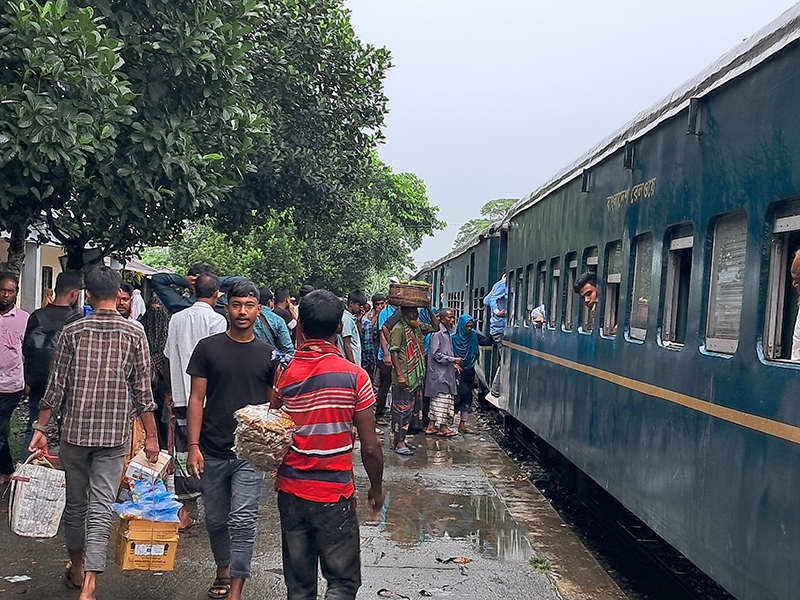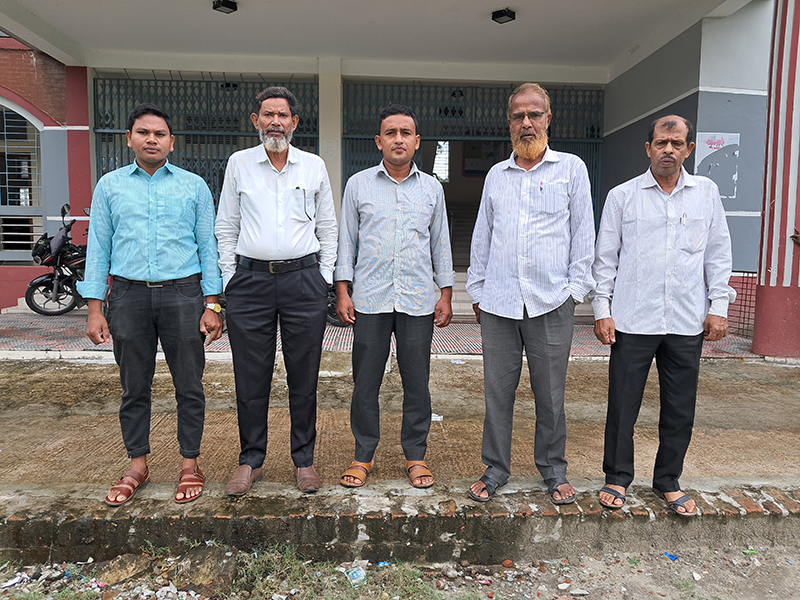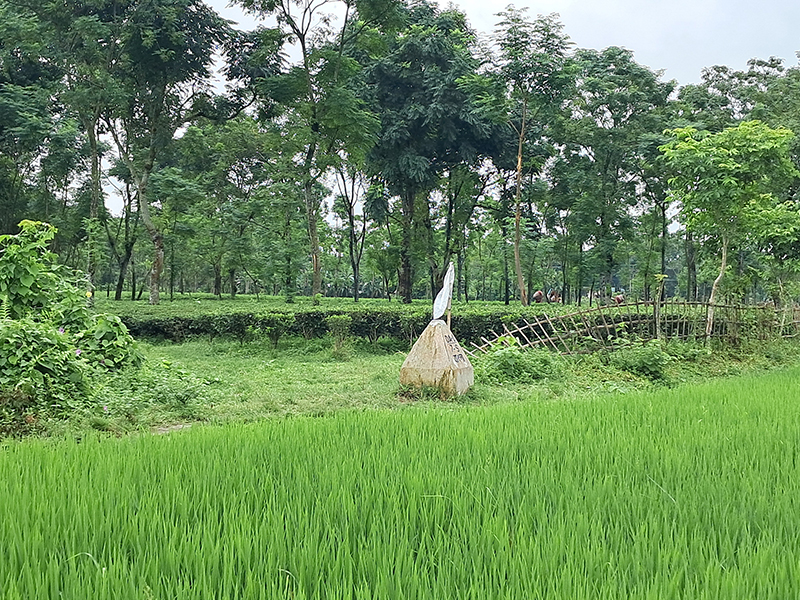
Published :
Updated :

The moderate rain on an autumn morning reminds me of this year's prolonged monsoon as I arrive at the Lalmonirhat railway station. The station is a short rickshaw ride from Mission More, the northern district's main roundabout lined with hotels, restaurants, and shops. At the centre of the roundabout stands a white landmark topped with a large, silver-coloured sphere.
Lalmonirhat is a station I have fallen in love with instantly. The small fenced garden in front of the two-storey, beige building; the lush green surroundings with big trees; and the classic red-brick railway establishments enchant me. Walking around it feels like going back to the British period, when Lalmonirhat emerged as a major railway hub in East Bengal.
Six people queue ahead of me at a small counter, where a woman collects fares and hands tickets after date-stamping them. I buy a Burimari Commuter ticket for Tk 40 to travel to Patgram, an upazila of Lalmonirhat where Bangladesh's only enclave surrounded by Indian territory is located. The ticket shows a travelling distance of 74 kilometres by a second-class commuter train.
It is a pleasure to wait for the train while listening to the pitter-patter of the rain on the platform's corrugated metal roof. With two headlights of the locomotive turned on, the Burimari Commuter soon enters the platform, its carriages soaked in rain. Passengers scramble to get aboard as seats are not allotted on such trains.
Though the train has arrived early, it stands still even after the departure time. My seatmate, Md Nasir, says delays are common for this train. We finally pull out of the station 20 minutes behind schedule and soon curve around a level crossing (LC) gate.
Across me sit two elderly men with white moustaches and beards. The one I am facing grasps the tied-up mouth of a white plastic sack, which is too big to fit into the rack above. I ask him what he is carrying in the sack.
"Jarda (chewing tobacco). I have my own production unit here and sell the product in Barakhata [a union in Hatibandha upazila]."
"Is it Hakimpuri jarda?"
"No. Monipuri jarda is popular in Lalmonirhat, not Hakimpuri."
Many of the male passengers, especially the old ones, are in lungis, while most women have worn burqas and covered their faces. Some of the bench-like seats are shared by three persons, their conversations indicating they are family members and relatives. Sobar Jibone Prem Ashe, a romantic film track that enjoyed immense popularity in the 90s, plays in low volume on someone's phone, creating an aura of nostalgia in the wood-coloured carriage.
Burimari, the terminus of the train, lies near the Bangladesh-India border. Bengal Dooars Railway, a pioneering rail company in British India, built the Lalmonirhat-Burimari line in several phases in 1900. It was built as part of a main line that aimed to develop the tea industry in Dooars, a northeastern Indian region at the foot of the Himalayas with forests and tea gardens in abundance.
The main line ran up to Malbazar, a key town in Jalpaiguri district and gateway to Dooars. But the 1947 partition of India severed the link. Trains on the Indian side then terminated at Changrabandha, while Burimari became the terminus in what was then East Pakistan.
When we reach our first stop in Roisbagh, the rain has subsided and the clouds have disappeared. A few rickshaws wait at the LC gate adjacent to the station, which has a name board but no platform. Nasir says the small station building is no longer used, which is why Roisbagh has become more like a rail gate.
It starts raining again on the way to the next station in Aditmari. This is where locals blocked the Burimari Express intercity train on its inauguration day in March last year, demanding a scheduled stop. Protesters lay down on the tracks when the train arrived from Lalmonirhat, but lifted the blockade after assurances that their demand would be met.

Passengers get on and off the train at the Baura station in the Patgram upazila — FE photo
In Lalmonirhat's five upazilas up in the north, the railway is more than a mode of transport - it is a lifeline. The Lalmonirhat-Patgram section lacks direct bus services, meaning someone in Patgram cannot just ride a bus to go to Lalmonirhat whenever they want. This constraint has not only increased dependency on the railway but also turned a simple train stop into a coveted asset for the predominantly rural communities.
These communities are mostly engaged in agriculture, growing rice and maize in the land that sits on the active Teesta floodplain. Besides, they grow vegetables, including eggplant, bottle gourd, cabbage, and tomato. Despite being aware of the health risks, farmers also cultivate tobacco on a wide scale, particularly in Aditmari, as companies incentivise them in many ways, such as by providing seeds, fertilisers, and pesticides for free.
Though it is a local service, our train runs quite fast. A train moving through the countryside offers one of the best views of how rain washes the world clean, which I now enjoy from the carriage door. The rain breathes new life into the rural landscape, turning the crop fields, as well as bamboo, betel nut, and banana trees, livelier.
But the horizon gives the impression of winter. It looks hazy, and the distant tree lines seem to be covered in thick mist under the grey sky filled with dark clouds. Rainwater drips from the doorframe onto my face and arms - a small discomfort I accept delightedly.
With umbrellas resting against their shoulders, a few farmers work in fields. Uniformed schoolchildren, some of them huddled together under colourful umbrellas, tread wet paths. The cows and goats grazing in the open are the exception, getting drenched and showing no urgency to seek shelter.
But there is urgency among passengers waiting in the stations to get on board. As soon as the train stops, men and women, gripping their umbrellas, rush to the doors that are less busy. The doors then become too busy as lots of passengers gather there, jostle, and attempt to get on before others from inside get off.
Most of the stations on this route are modest, single-storey buildings painted in beige and light grey. They have gated entrances in the centre, with waiting rooms on one side and station master rooms on the other. Three to four people can also sit comfortably on the red concrete benches built on the platforms.
The train leaves behind Kakina, Tushbhandar, Bhotmari, Hatibandha, Barakhata, and Baura stations, eventually arriving in Patgram. The rain shows no sign of abatement even after I disembark and watch the train rattle onwards to Burimari. Across the platform, shops line the street that leads to the Chowrangi intersection, from where I take a Dahagram-bound autorickshaw.
Dahagram-Angarpota is an isolated piece of Bangladesh, surrounded by the Cooch Behar district in the Indian state of West Bengal. It is connected to the mainland through a narrow strip of land called Tin Bigha Corridor, which India leased to Bangladesh in 1992 in line with the 1974 Mujib-Indira treaty. After years of limited access, the corridor was officially opened for 24 hours in 2011 under agreements signed by the then prime ministers of both countries.
The autorickshaw driver stops near the corridor entrance and tells me to take pictures from there as photographing is prohibited inside. At first glance, it looks like a leafy park shaded by shrubs and large trees. The corridor cuts through the compound fenced by barbed wires, with the gate painted in the three colours of the Indian flag - orange at the top, white in the middle, and green at the bottom.
Two Indian flags installed on the gateposts fly gently. Nearby, a beige, single-storey building looks like a guardhouse. Carrying a pillion passenger on his motorbike, a man comes from the other side and drives past me.

A group of teachers at the Dahagram Government High School — FE photo
The corridor is heavily guarded by India's Border Security Force personnel. One of them, standing behind a rostrum-like structure on an elevated platform near the entrance, keeps an eye as my autorickshaw moves ahead slowly. Near him, Indian autorickshaws and motorcycles run on a narrow street intersected by the corridor at 90 degrees.
Crossing the corridor is a mix of anticipation and tension. There is the anticipation of seeing the land and the people on the other side, and the tension of heading to a part of my native land under the close watch of another country's border guards. There is a strange silence all around, broken only by the rumble of a few autorickshaws and motorbikes.
"The corridor gate did not exist when I was posted here. I started working only after the gate was opened in 1992. I lived in Patgram at the time, and still do," says Niranjan Karmakar, an assistant teacher of mathematics at the Dahagram Government High School.
The school is near Bonger Bari, where the autorickshaw has dropped me off. Inside the walled compound, there are several school buildings and a large, grassy playground. In the spacious teachers' room, I converse with Niranjan and several other teachers about life in the enclave.
Niranjan recalls how the corridor's inauguration was delayed because of the opposition of the nearby West Bengal residents. They argued they would have to use the Teesta waterway to go to Dhapra, an area in Mekhliganj of Cooch Behar, if the corridor was given to Bangladesh. Their opposition was backed not only by then West Bengal chief minister Jyoti Basu but also the central government.
The school has 510 students, nearly all from farming families. Watching the surroundings on my way to the school from the corridor, I have already predicted agriculture is the main source of livelihood here. With ponds, a wide variety of trees, and a vast expanse of crop fields, the landscape is impossibly green.
Bamboo and other trees line the main road, which is paved and appears slick due to the rain. This is in an idyllic northern area that blends natural beauty with rustic serenity. According to government statistics till July 2024, as much as 1,598 hectares of the 1,868-hectare land that makes up the Dahagram union are used for agriculture, with farmers mainly cultivating rice, maize, jute, wheat, and tobacco.
The school's acting headteacher Md Mahbuber Rahman says the institution has adequate infrastructure, but there is an acute teacher shortage. Only three teachers are on the government payroll, and seven are working as guest teachers. Fresh recruitments on the payroll are essentially impossible because only seven teaching posts - a headteacher, an assistant headteacher, and five assistant teachers - were created when the school was nationalised in 2013.
But this crisis can be solved even with the existing payroll, the teachers argue. They suggest the education ministry offer a special financial package for guest teachers or appoint teachers with guaranteed salaries under special arrangements, considering the school's unique geographical location. This can motivate teachers from the nearby upazilas or districts to work here.
From the school's silver-coloured gate, another autorickshaw carries me to Angarpota. Driving past a Border Guard Bangladesh camp, the driver takes a wet, earthen path and stops where it is no longer accessible by the vehicle. Getting off, I follow him to the last milestone of Angarpota, installed in the front yard of the last house in the area.

A demarcation pillar on the Bangladesh-India border in the Dahagram-Angarpota enclave, which is surrounded by West Bengal’s Cooch Behar district and connected to mainland Bangladesh through the Tin Bigha Corridor — FE photo
He says the Indian border is just a few yards away, but I only see cropland ahead. We walk along a vibrant green paddy field, watching a weathered grey border pillar take shape, a white piece of cloth hoisted on it using a stick. Without barbed wire fencing or armed guards in sight, the demarcation feels liberating instead of forbidding.
"I thought there would be a large physical border here with tight security arrangements like the Tin Bigha Corridor," I tell the driver.
"No. Only the border pillar is here."
"What about the tea garden over there?"
"That is in India. You cannot go there."
r2000.gp@gmail.com


 For all latest news, follow The Financial Express Google News channel.
For all latest news, follow The Financial Express Google News channel.